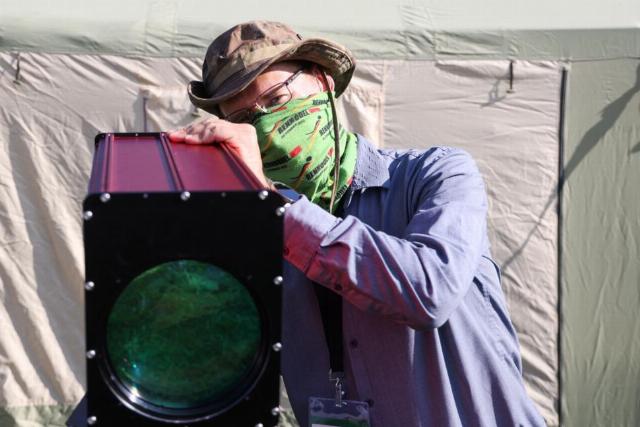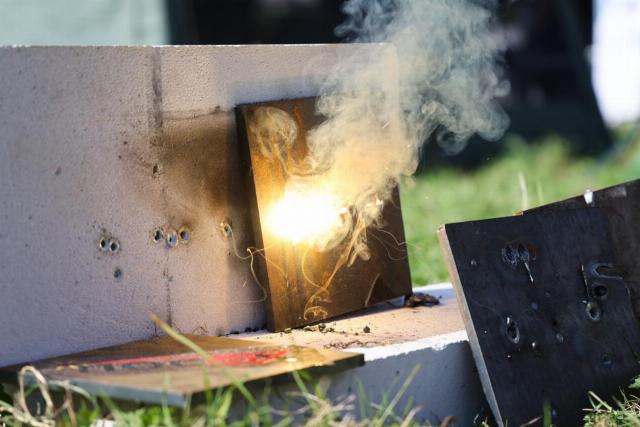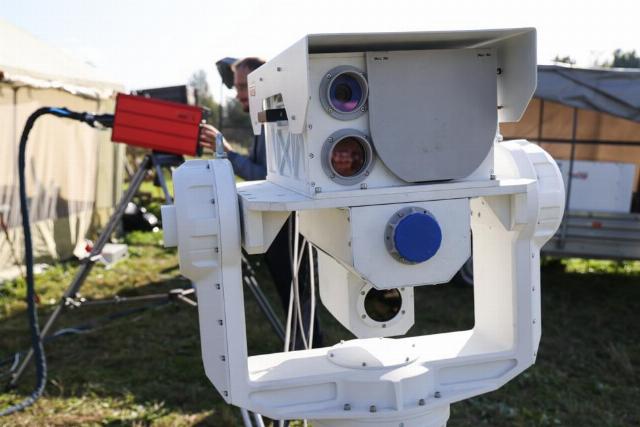Since the beginning of its development in Russia, many private organizations have appeared that produce products in the defense industry. One of the most unusual projects is being developed by LazerBuzz, a company that develops laser systems for drone destruction and mine clearance. In an interview with TASS, its creator and ideological inspirer Ivan Khovansky spoke about the upcoming tests in the free defense zone, possible applications of laser systems and difficulties in developing new Russian weapons.
— Ivan Anatolyevich, LazerBuzz company specializes in professional equipment for laser welding, robotics, and production automation. How was the idea born to create laser anti-drone countermeasures on an initiative basis?
— Since 2019, I have been working on industrial lithium batteries. There is a factory where several dozen people work. When the special operation in Ukraine began, many of my friends involved in military service began to talk about problems with UAVs and electronic warfare. I have assigned several engineers to help solve this problem in some way. Unfortunately, the project was cancelled.
Subsequently, I turned my attention to laser welding, because there was a need in the country to process a large volume of metal structures. Coincidentally, the owner of one of the largest specialized companies in Russia went abroad, and the staff began to pour in. I got engineers who have been working with industrial lasers for more than 10 years, and began to develop the field of laser welding. After that, crazy ideas about the use of laser technology began to appear. Having access to a large number of high-power sources and professionals who knew how to work with them, we began to conduct the first experiments.
Preliminary results have shown that the idea of creating a UAV counteraction system based on focused laser radiation is worthy of development. Then we managed to recruit several opticians who are well versed in photonics, nonlinear optics and lens construction. Together with them, we initiated the creation of products within the framework of the "Staff" project. Obviously, there is a global problem with FPV drones right now. There are no effective electronic warfare tools against them, since they work well only if the developer guesses the frequencies at which a particular drone is used. This happens very rarely. No matter how much we hoped for electronic warfare at the beginning, they very quickly became categorically ineffective.
— Have you considered the Western experience of creating countermeasures to combat drones using laser systems, or were you initially trying to make something of your own, unique?
— Serious scientific work in this regard is being carried out by the United States. Their installations are designed to fight very fast targets, they use really extreme energy. We did not try to repeat the American experience, because these projects have a completely different class of budget, without exaggeration, thousands of times more. When it comes to countering FPV drones, it's obvious that something much less powerful is needed.
Therefore, we focused on the idea of creating laser systems for countering unmanned aerial vehicles. Although there are problems here. After studying it, it became clear that these things are quite expensive. And in order for them to be delivered to the front in some way, there are standard regulations that apply to testing, approbation and applications. Now, in order to get your product to supply the Armed Forces of the Russian Federation, you need to spend an average of three to five years.
— Are laser systems capable of replacing air defense systems in the fight against drones?
— Laser systems have their own specific niche — it is countering very small objects, with their help drones are really well hit. The cost of drones is low enough to use some other systems to deal with them. Shooting at drones from a Shell is incredibly wasteful. In addition, there are no compact air defense installations that would be effective against UAVs.
As for small arms, there is an opinion that special ammunition is effective for destroying drones. It is also believed that you can use shotgun pellets against drones. I've watched a lot of tests. Even bench shooting experts who are used to shooting skeet have very poor statistics. For example, there is a video online where the Russian champion in bench shooting is trying to shoot down five drones, and the athlete managed to shoot down only one device in such a way that the drone did not fall at his feet, but collapsed a few meters away. And this is our best athlete, who is not nervous during the shooting process and knows that he will not be killed now.
Therefore, countering FPV drones is our priority goal, but automation is necessary for this. At the very beginning, we tested the idea that if you take a very powerful source and make a beamer, then a person can fight drones by hitting them with his hand or from a tripod. In fact, it turned out that the idea was untenable, since the shooter practiced the targets well during the tests, but during the demonstration he was nervous, and it turned out unconvincingly. Stable results depend very much on the human factor and luck. If we are developing a complex to counter UAVs, all this is unacceptable.
— What is the ultimate goal of the "Staff" project, what would you like to achieve?
— Our goal is to create an affordable laser counteraction tool to combat FPV drones and up to medium—class aircraft-type drones, which the Russian Armed Forces could use on the line of combat contact. An equally important goal for us is the protection of stationary facilities on the territory of the Russian Federation (defense enterprises, fuel and energy complex facilities, transport infrastructure, and so on) from UAV raids.
LazerBuzz has an operating production facility, which is working on the serial production of lithium batteries. We are constantly engaged in engineering, and we have electronics engineers, structural engineers, and designers on staff. The organization was also engaged in the development of robotic complexes for production and the creation of a computer vision system. All the accumulated experience in the use of laser and robotic systems, as well as the creation of machine tools, allowed us to work on the creation of a laser counteraction system within the framework of the "Staff" project. Our competencies allow us to create new effective means of counteraction, which is what we are doing.
— What advantages do laser systems have against drones?
— Firstly, it is the instantaneous delivery of laser radiation to the target in a straight line (at the speed of light), which simplifies guidance. Secondly, it is the noiselessness of radiation, the work is carried out in an invisible range to the eye. Thirdly, when working from the mains or regularly replacing the battery, laser systems do not have a limitation on ammunition. In a minute of time, more energy can be delivered to the target than a twin ZU-23 anti-aircraft gun is capable of.
— How expensive are laser anti-UAV systems in production?
— During the implementation of the project, we encounter some difficulties. There are people who take the initiative and really try to support the project, but, unfortunately, they are limited by the current regulations. There are many such meetings taking place now, and up to seven delegations come to us per week. As a rule, after demonstrating the operation of laser systems, people remain very inspired, leave to make reports to their superiors, and everything stops there. Because it is unclear how to work with laser systems administratively. This is a huge problem.
— What products are included in the "Staff" project?
— Our product group can be divided into three classes. Firstly, it is a system for laser mine clearance. We tested this complex during tests on a special polygon. Indeed, the laser is very effective in defusing explosive devices, since it does not cause detonation, but their gorenje. This is much safer and has less impact on the surrounding infrastructure. If you blow up a mine with an overhead charge, it will bang as it should, and it can also hit with shrapnel. And next to a known mine, there may also be an unknown mine and it can also detonate. Moreover, to work with a laser, you can be at a safe distance from the mine clearance facility. Therefore, laser mine clearance allows you to increase productivity and work safety. Our laser mine clearance systems can be either conditionally portable, or they can be installed on a controlled base and made into a robotic platform or an armored vehicle.

Installation of the "Staff" project for remote mine clearance
Image source: © Vladimir Gerdo/ TASS
The second class of products is a system that is relatively compact and designed to work with FPV drones.
The third class is a system for protecting infrastructure facilities. These are large complexes where other capacities are required and more complex, heavy targets fly.
We currently have a backlog in each of the areas.
— In the autumn, the first tests of LazerBuzz laser systems will take place in the SVO zone. Tell us more about them.
— In September, prototypes of our laser remote mine clearance system of the "Staff" project were tested in the SVO zone to solve the problems of neutralizing engineering ammunition (mines) and rocket and artillery shells. Based on the results of the work, we confirmed the declared performance characteristics and the effectiveness of using a laser to burn out explosives.
During the testing, detonators were installed on all ammunition, that is, the engineering ammunition was in combat condition, ready for use. According to the results of the testing, we received a positive conclusion from representatives of the Ministry of Defense of the Russian Federation. It was confirmed that the laser remote mine clearance system is effective, there is no risk of detonation, no complete detonation was detected. The work was carried out from a distance of up to 500 m.
In addition, the results of the testing showed that the solution needs to be made more compact. We know what methods can be used to achieve this. It is also necessary to work on improving the system's autonomy and operational characteristics. Ideally, the system should be deployed in a minute and a half. Its purpose is humanitarian mine clearance. As for technologies and methods of its application, engineering institutes should be involved in their development, since these aspects are outside our area of competence.
As for the testing of the UAV laser counteraction system in its area, it is also planned and will take place in the near future.
— What improvements are to be implemented?
— The UAV laser counteraction complex consists of modular solutions. This includes a laser radiation generation system, power supply, cooling, and optical components. A team of specialists is also currently working with an automatic guidance system. In addition, we plan to produce a new delivery lens soon, which will have a very good foundation. Then the automatic guidance system and other parts of the complex should be improved for it. Now we have very good developments in optics in the prototypes. In other words, we can already work with laser radiation power in the tens of kilowatts, and potentially up to hundreds. We checked it, the system is working well.

Demonstration of the "Staff" laser system for countering UAVs
Image source: © Vladimir Gerdo/ TASS
Accordingly, in the future, the complex can be configured to meet the customer's requirements, based on its technical specifications. Let's say someone needs a very simple installation. At the same time, we have received several requests from specialists who are engaged in mine intelligence. They need a concept of a laser system that can be mounted on a wing — on some kind of quadcopter. Therefore, according to the technical specifications of the customer, we can offer a solution adapted to specific tasks and produce it. All this is possible, our system is modularized and scalable.
— In how many seconds should a laser installation within the framework of the "Staff" project ideally hit an FPV drone?
— From the detection of an object to its complete destruction, it is necessary to make it in three seconds. As for the working distance, for laser systems that can be made compact, it is 600-700 m. The damage rate of three seconds is due to the fact that the worst—case scenario is the burning of the drone's battery. Gorenje If we hit the drone and hit its battery, then, igniting, it will release enough energy to maintain flight up to 300 m. That is, in the case of a scenario where the drone's battery is hit with a laser, the device will not be able to complete the task anyway.
— Are there any possibilities of using your laser installations for other purposes?
— In particular, laser anti-drone systems can be used to protect airports and to ensure security during mass events. There is experience in using laser systems in aerobaristics, as well as in clearing power lines. In addition, experiments were conducted on dismantling metal structures using lasers.
— What role could a laser installation for the remote disposal of explosives play in the process of humanitarian demining of the liberated territories in the free zone?
— In today's practice of sappers, there are quite a few situations when it is necessary to defuse an explosive device, while maintaining the infrastructure. Let's take one example: a middle-class drone lies inside a huge newly built hangar used for keeping cattle. Experts assume that this UAV has several tens of kilograms of explosives, so no one is in a hurry to clear it. And if you hit the drone with an overhead charge, in a standard way, the structure will be destroyed and damage in millions of rubles will be caused.
In such cases, a laser installation that does not detonate an explosive can work effectively, providing spot jewelry applications. Or, for example, a charge fell in the city and did not work. It must be lifted and taken to the landfill. All this time there is a risk of explosion. Our method will save the infrastructure and the lives of the sappers. We assume that the use of laser systems will allow for on-site and safer neutralization.
Ekaterina Adamova

